COFFEE & COFFEE MACHINES
Home 3Equipo ShopEspresso MachinesSemi-Automatic Espresso MachinesBreville Barista Express Espresso Machine, Brushed Stainless Steel, BES870XL, Large
Breville Barista Express Espresso Machine, Brushed Stainless Steel, BES870XL, Large
Rated 4.86 out of 5 based on 7 customer ratings
(7 customer reviews)
$749.95
| Brand | Breville |
| Capacity | 4 Pounds |
| Color | Brushed Stainless Steel |
| Product Dimensions | 13.8″D x 12.5″W x 15.9″H |
| Special Feature | Manual |
- The Breville Barista Express delivers third wave specialty coffee at home using the 4 keys formula and is part of the Barista Series that offers all in one espresso machines with integrated grinder to go from beans to espresso in under one minute.Grind Settings : 16 precision grind settings, Tamping : Manual removable magnetic tamper,
- DOSE CONTROL GRINDING: Integrated precision conical burr grinder grinds on demand to deliver the right amount of freshly ground coffee directly into the portafilter for your preferred taste with any roast of bean
- OPTIMAL WATER PRESSURE: Low pressure pre-infusion gradually increases pressure at the start and helps ensure all the flavors are drawn out evenly during the extraction for a balanced tasting cup
- PRECISE ESPRESSO EXTRACTION: Digital temperature control (PID) delivers water at precisely the right temperature, ensuring optimal espresso extraction
- MANUAL MICROFOAM MILK TEXTURING: The powerful steam wand performance allows you to hand texture microfoam milk that enhances flavor and enables creation of latte art
- ESPRESSO MACHINE WITH GRIND SIZE DIAL: Simple and intuitive, giving you control over the grind size no matter what type of bean you’re grinding
- ESPRESSO MAKER WITH BUILT-IN COFFEE GRINDER: Innovative grinding cradle allows any at home barista to grind directly into the espresso portafilter for the perfect espresso
SKU: B00CH9QWOU
Categories: Espresso Machines, Semi-Automatic Espresso Machines
Tags: Espresso Machines, Semi-Automatic Espresso Machines
Description
The barista express from bean to espresso in under a minute create great tasting espresso in less than a minute. The barista express allows you to grind the beans right before extraction, and its interchangeable filters and a choice of automatic or manual operation ensure authentic café style results in no time at all.
Important information
To report an issue with this product, click here.
Additional information
| Weight | 23 kg |
|---|---|
| Dimensions | 13.8 × 12.5 × 15.9 cm |
| brand | Breville |
| Capacity | 4 Pounds |
| color | Brushed Stainless Steel |
| Product Dimensions | 13.8D x 12.5W x 15.9H |
| Special Feature | Manual |
| Coffee Maker Type | Espresso Machine |
| material | Stainless Steel |
| Filter Type | Foam |
| Style | Espresso Machine |
| Specific Uses For Product | BeginnerHome |
| Exterior Finish | Stainless Steel |
| Included Components | |
| Operation Mode | Manual |
| Wattage | 1600 watts |
| Voltage | 120 |
| Model Name | BES870XL |
| Number of Items | 1 |
| Human Interface Input | Dial |
| Package Type | Standard Packaging |
| Unit Count | 1.0 Count |
| Item Weight | 23 Pounds |
| Department | Unisex-adult |
| ASIN | B00CH9QWOU |
| Item model number | BES870XL |
| Date First Available | February 16 2010 |
| Manufacturer | Breville |
7 reviews for Breville Barista Express Espresso Machine, Brushed Stainless Steel, BES870XL, Large
Add a review Cancel reply
Related products
-
-
-
-
-
Nespresso Essenza Mini Espresso Machine by Breville,0.6 Liters, Piano Black
$154.90Add to cartRated 4.50 out of 510
























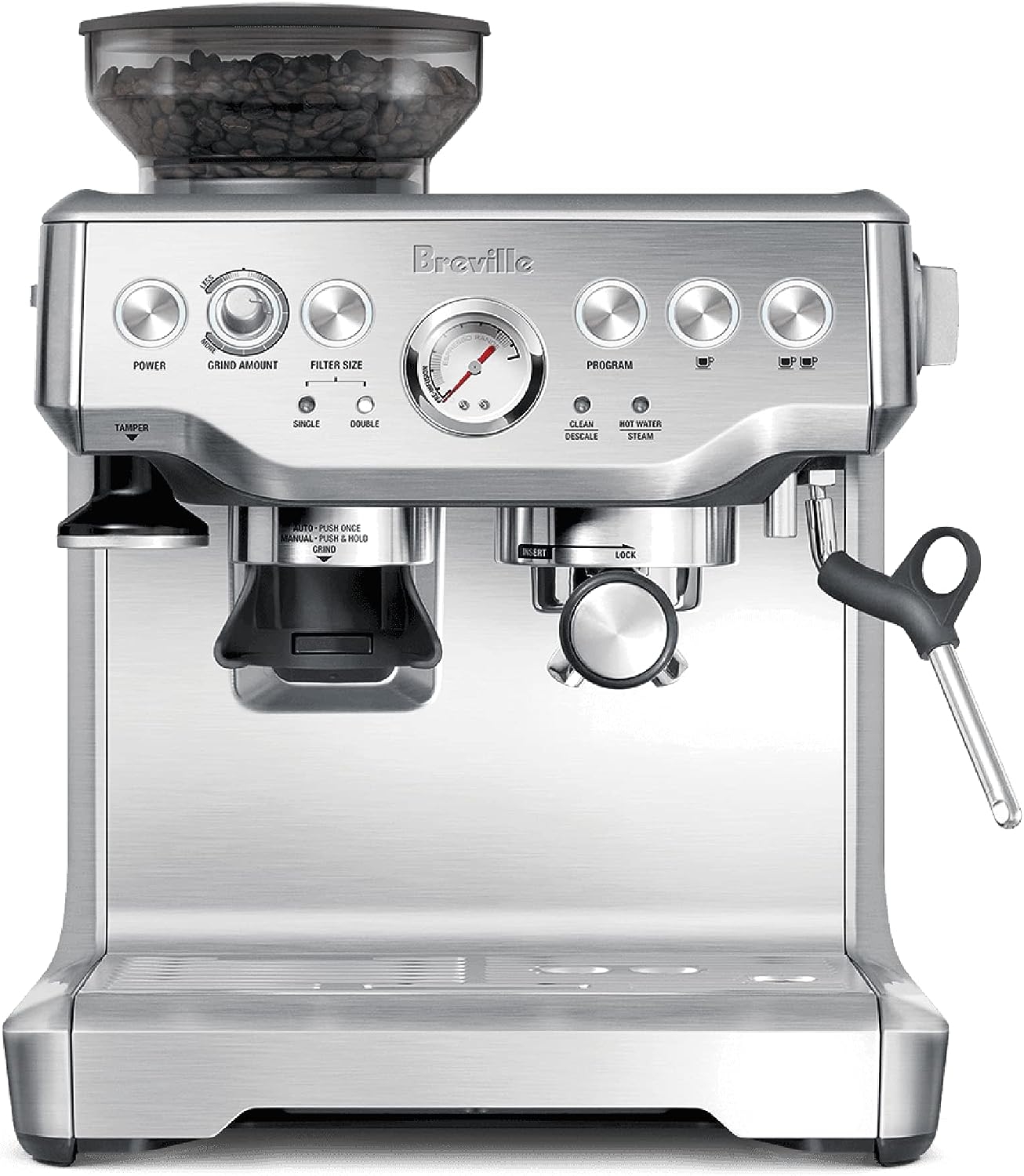
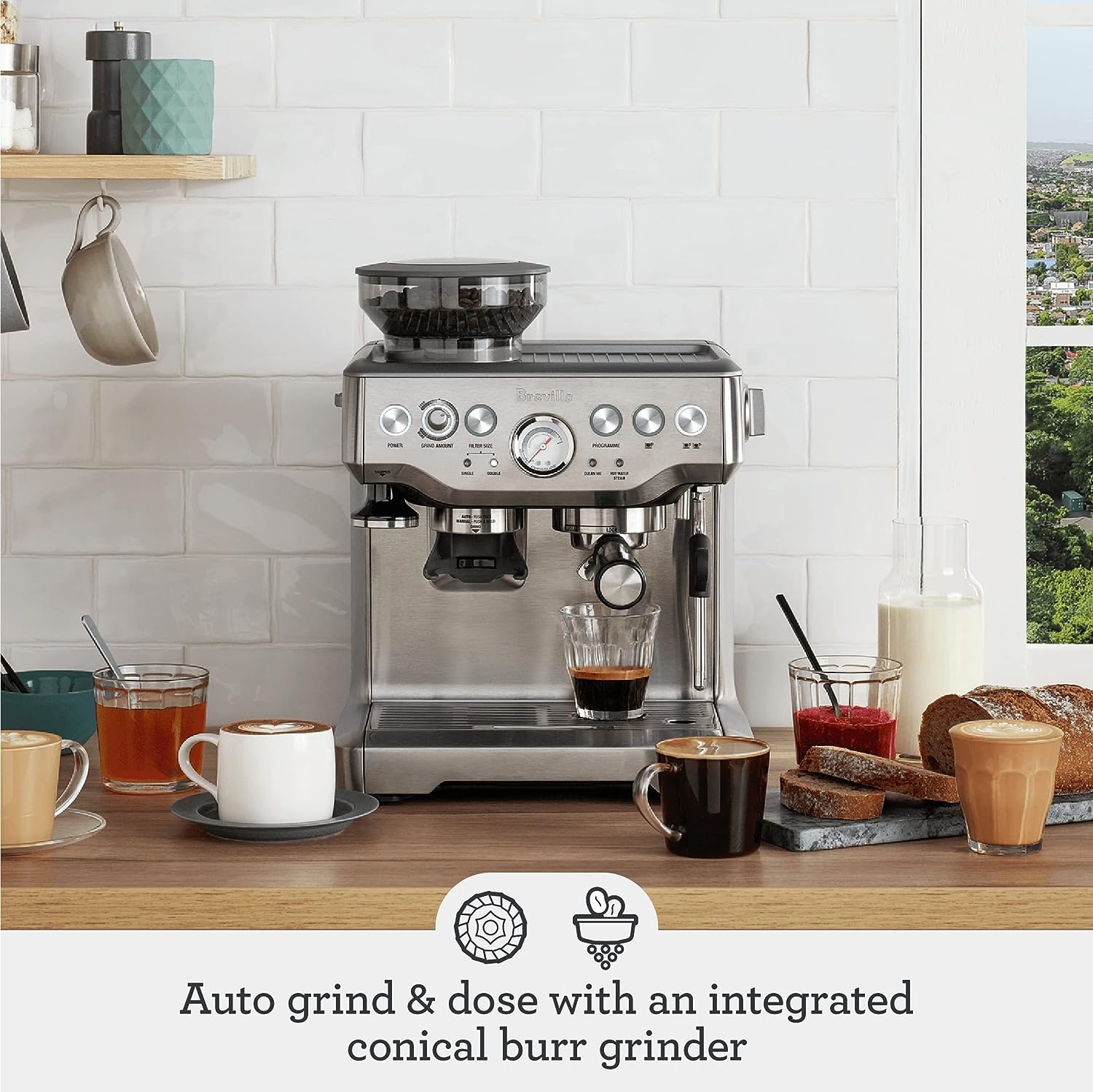
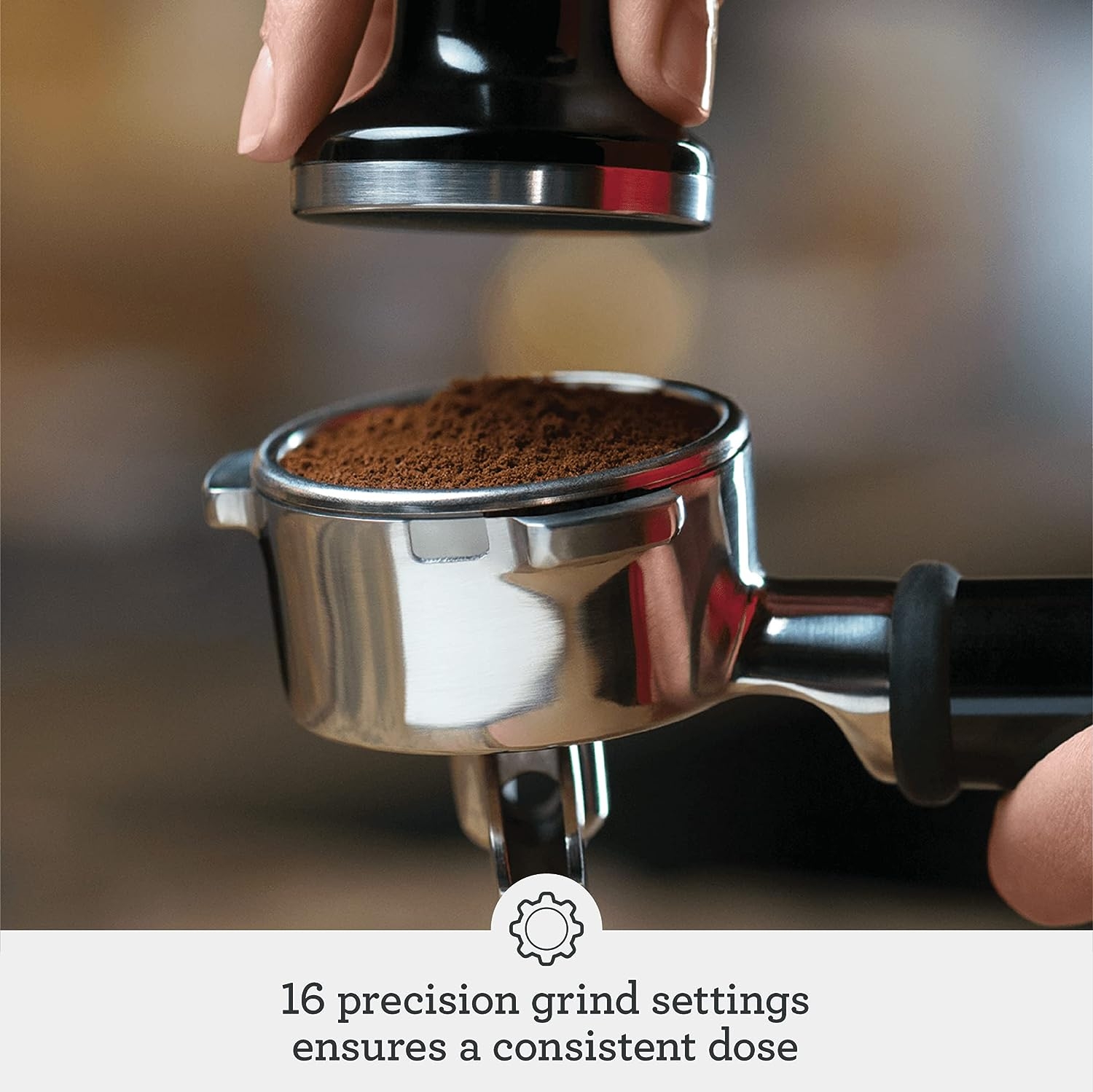
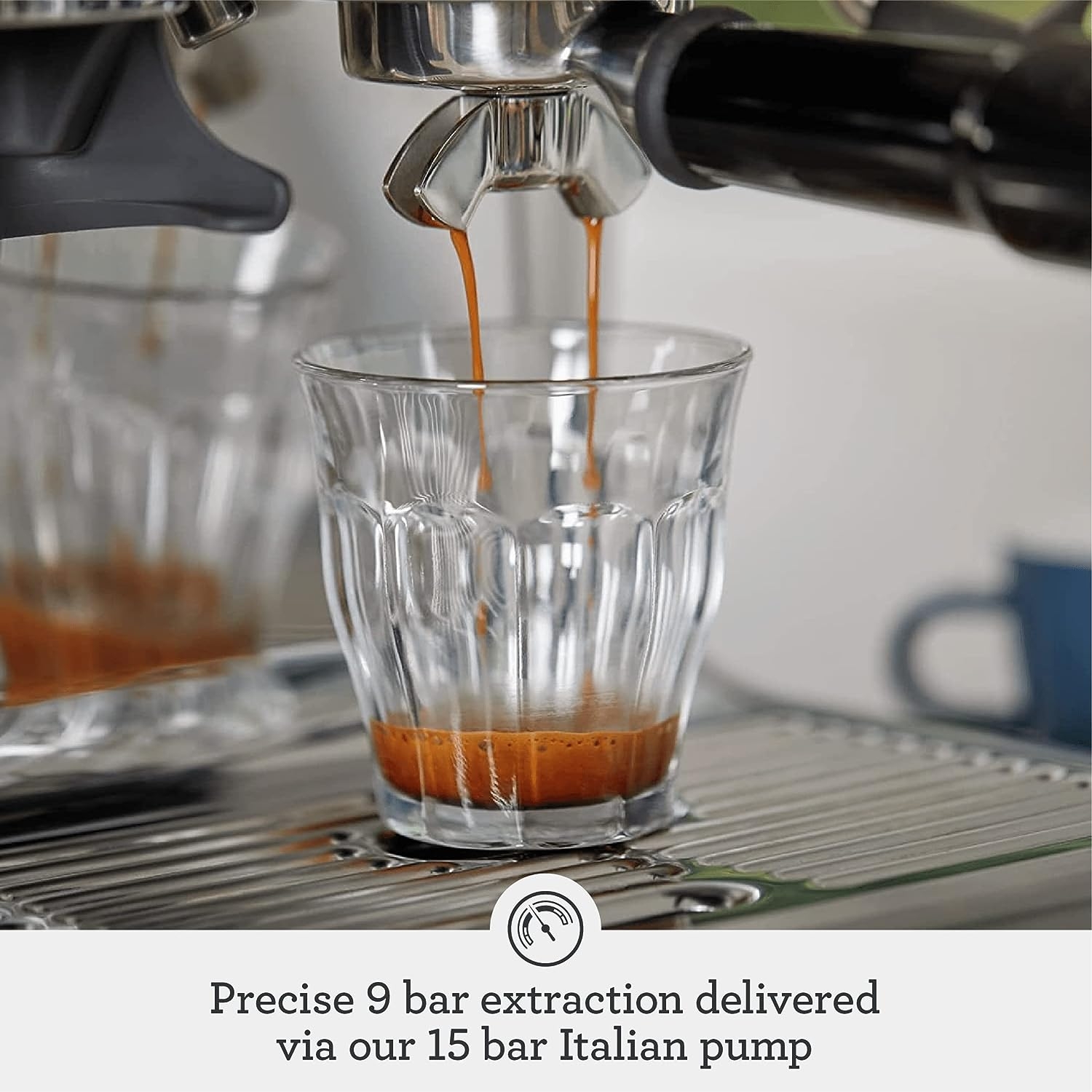
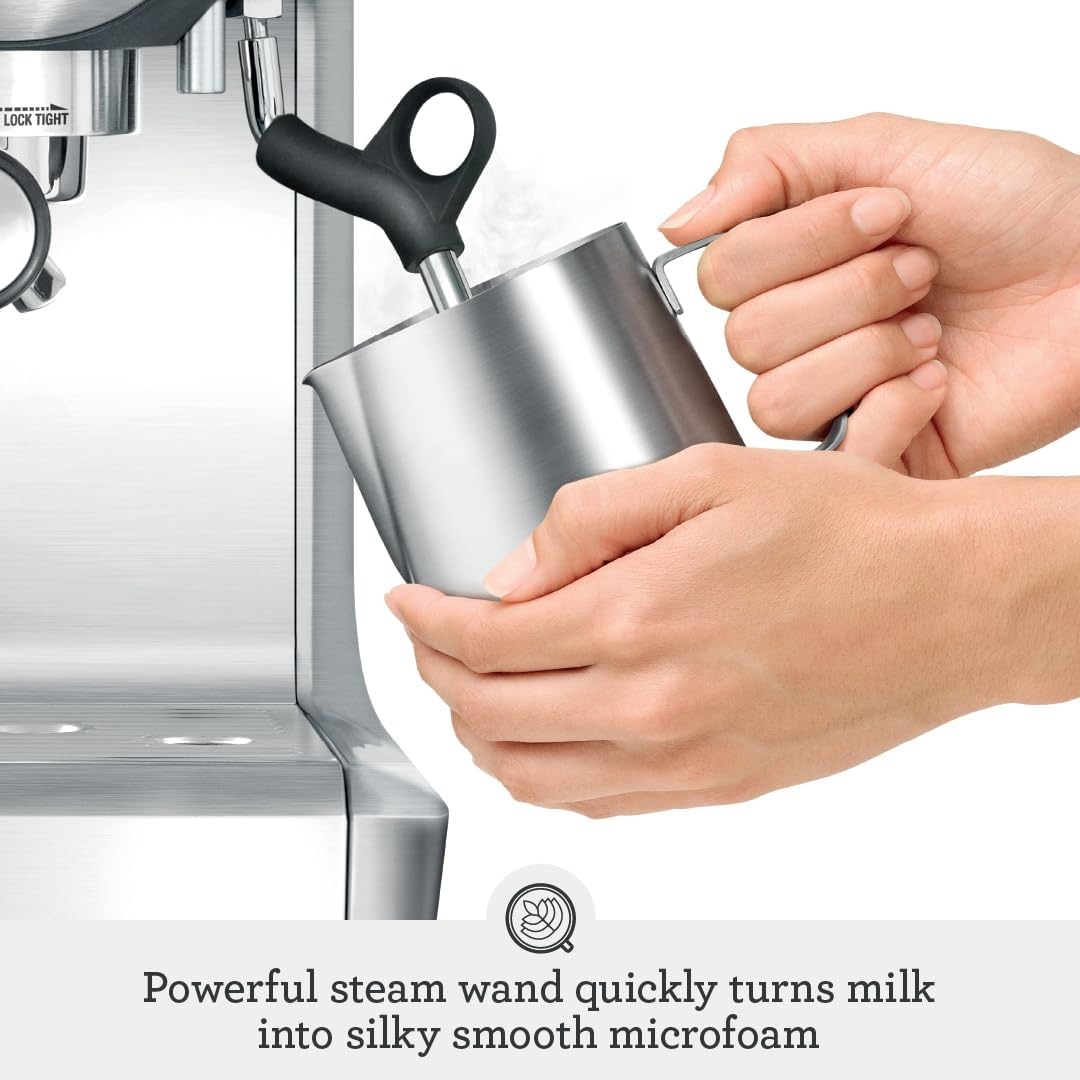
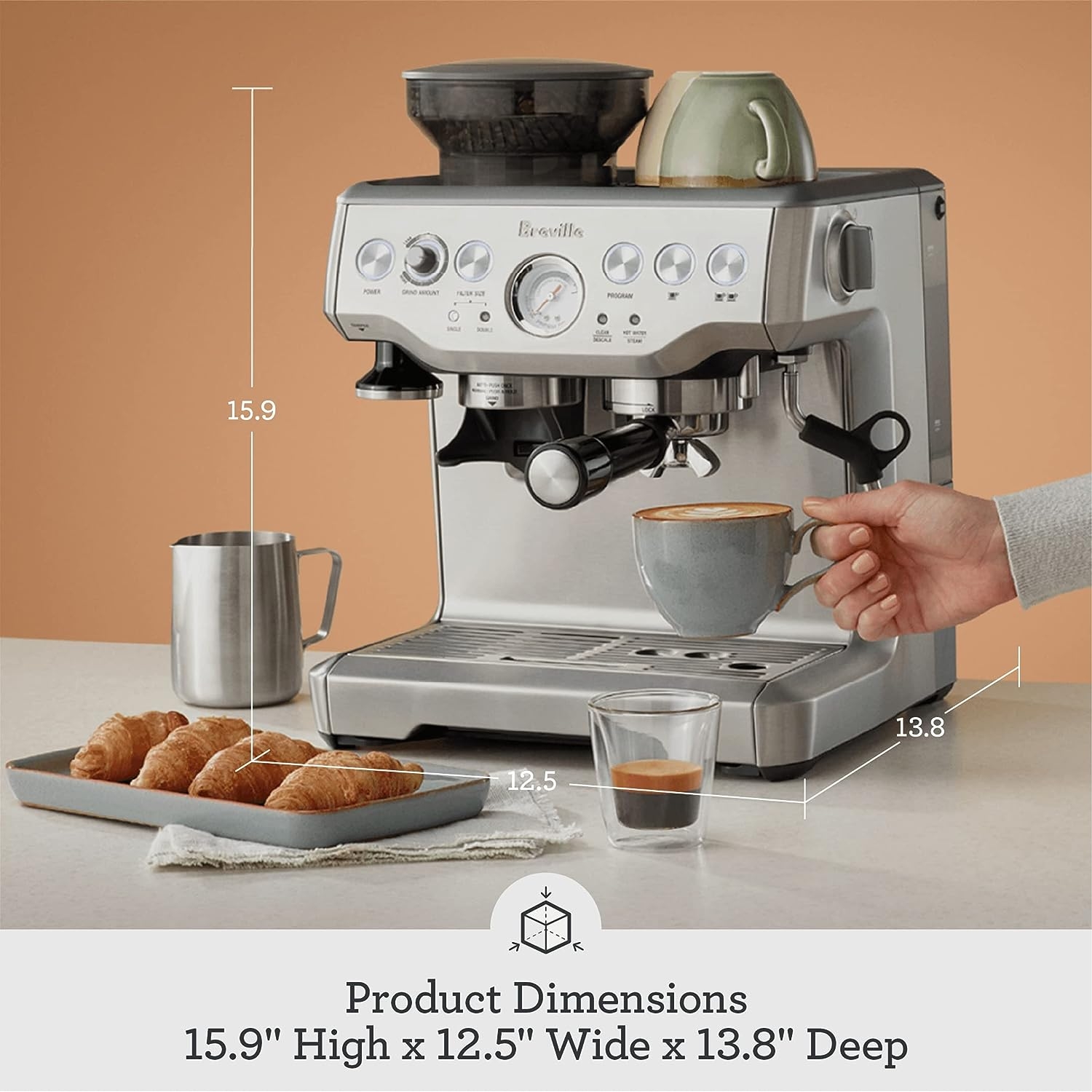
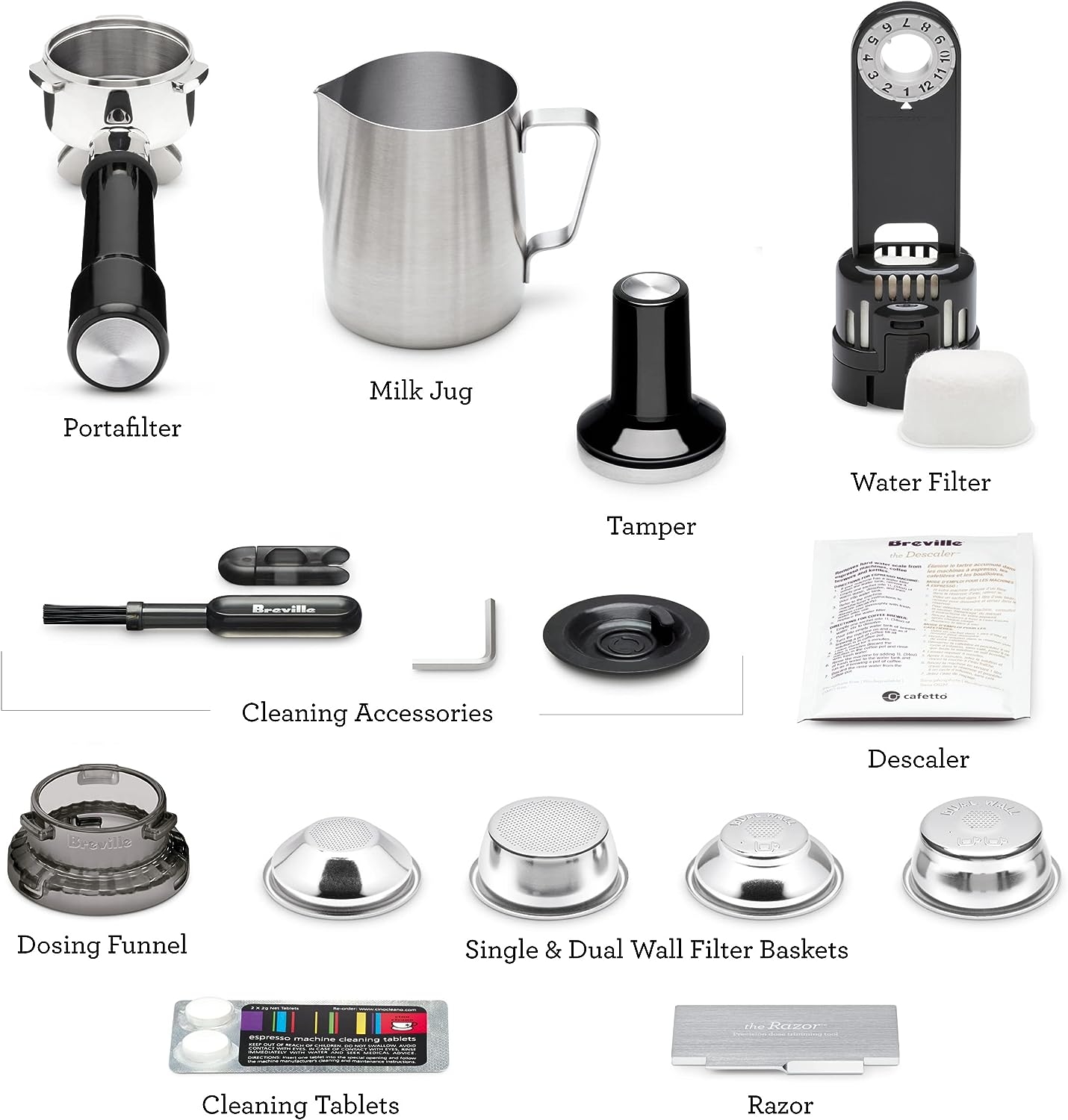
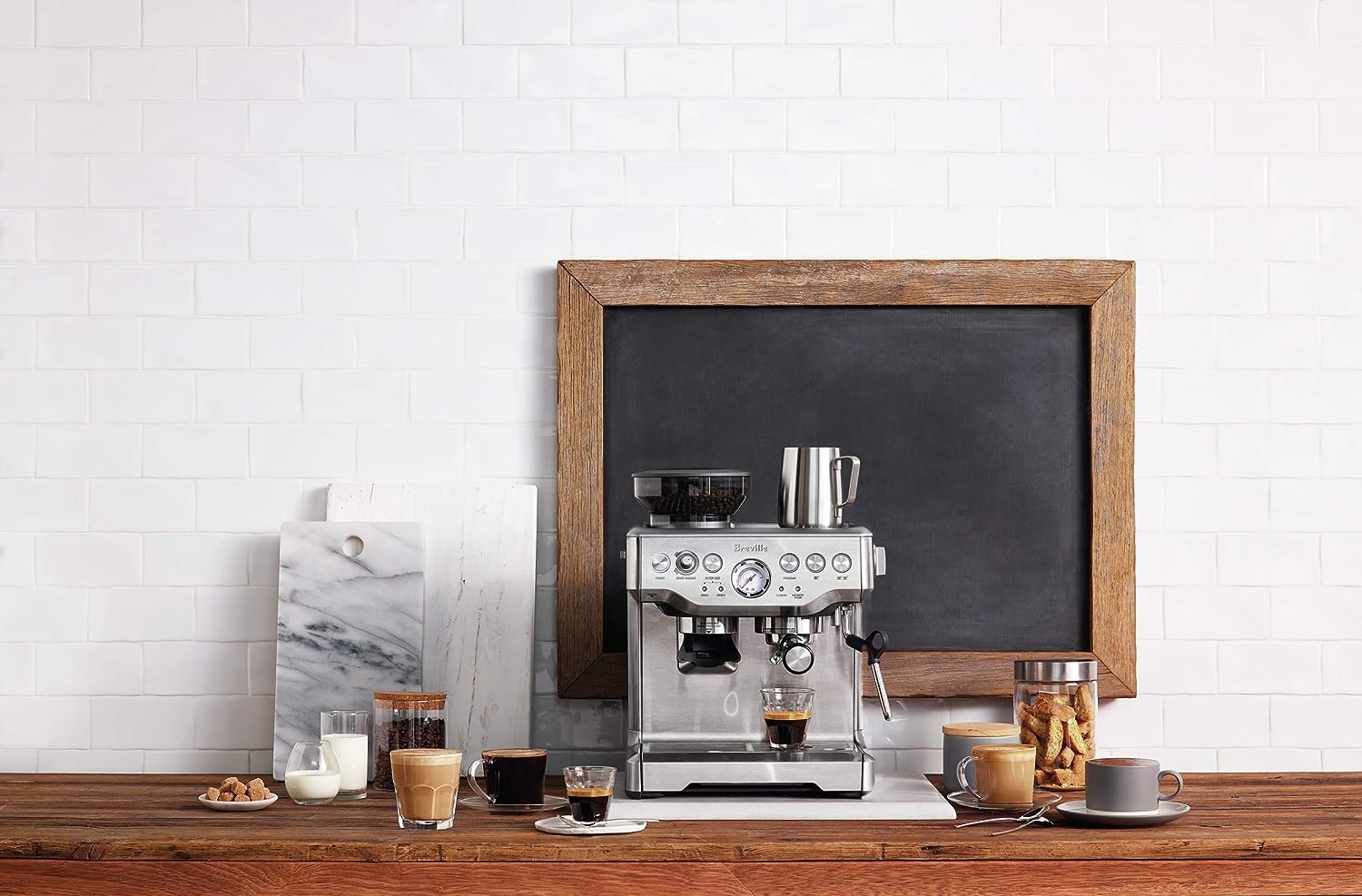


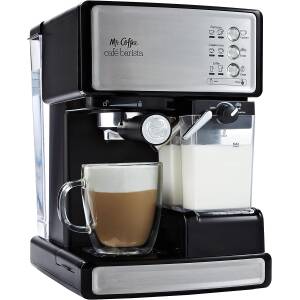


VR –
Despite some of the negative criticism sprinkled throughout this review, keep in mind that (1) I am giving this machine 5 stars, and now that I have spent a few weeks getting to know it (intimately), I love it – so much, that if a burglar broke into my house and stole it, I would order another one the same day – I have not been back to Starbucks since. All that being said, you NEED to read this review so that your machine does not frustrate you and so that you get the most out of it. Read on my coffee-loving friend:1. I am a guy, who knew nothing about espresso machines before this. I am very mechanically inclined and don’t usually read instructions. This was different – this machine is NOT self-explanatory and you NEED to read the instructions (which are well written, and even include a troubleshooting section). Don’t get frustrated with this machine until/unless you have read (all) the instructions.2. This is not a ‘stand-alone’ purchase … this machine costs around $500 (give or take), you need to invest another $100 right from the start (preferably at the same time) to get the most out of it, enjoy it to the fullest, and not get unreasonably frustrated by making your own lattes and mochas.3. The other things you REALLY should order at the same time (and all are available on Amazon) are: a. ($29) 100-pack disposable 20oz. cups with lids and sleeves (sold by Yes!fresh). Trust me, you want to get these. It’s only $0.29 per cup and are far more convenient that trying to clean out a million dirty coffee cups from your car/office each week. These are worth twice what they cost in the long run. And when your friends are over, you need not ‘loan’ them a nice coffee cup to go (which you may never see again) – just give them a paper cup to take with them. b. ($5-15 for 25 oz. / $20-30 for 64 oz.) Torani syrups and sauces, AND the pump tops that go with them (always sold separately). IF you drink the same thing on a regular basis (like I do) such as a white chocolate peppermint mocha, buy the 64 oz. white chocolate sauce and not the smaller 25 oz. bottle. c. ($14) Amazon Basics Cotton Washcloth – 24 pack – grey (the grey matches the espresso machine, but the color doesn’t matter). Again, trust me, you want a nicely folded stack of these sitting next to the machine – you will use 1 each time you make espresso, and then it will be dirty and needs to be washed. At my house (3 people using the machine) we bought two 24-packs because we make so much coffee – two 24-packs is not too many for our house (I’m thinking about buying a third pack). d. ($10 for pair of single shot size, $15 for pair of double shot size) Set of double-walled espresso shot glasses. Do NOT buy the rounded ones (ie: Cutehom espresso coffee cups) because they will not pour very well and drip all over the place (down the side) each time – very frustrating. Buy the JoyJolt Javaah Double Walled Espresso Glasses instead – you’ll be glad you did in the long run. And, if you’re planning to make mostly double-shot lattes/mochas, buy a set of Dragon Glassware 6 oz Espresso Cups (also double-walled) so that you don’t have to keep fidgeting with the single shot cups to keep them in the right spot under the coffee dispenser. It’s important to buy double-walled glasses for two reasons. First, it keeps the espresso hot while you’re steaming your milk, second, it keeps you from burning your fingers when pouring the espresso into your coffee cup. e. ($15) Breville BCB100 Barista-Style Coffee Knock Box. Again, TRUST me, you want this right next to your machine – the coffee grounds will start piling up quickly and you don’t want your portafilter anywhere near a garbage can. This thing is a must.4. Space requirements: This machine (and all that you want to go with it) will take some counter space – allow AT LEAST 34-inches of counter width to accommodate – slightly more is even better. You will from my picture, this is a 34-inch setup, and there is no room to spare.5. Making espresso. After you read the instructions, here are some tips that they don’t include to help avoid frustration: a. When the beans are grinding, lightly knock on the top of the hopper lid (just like knocking on a door) so that the beans keep feeding down to the grinder (sometimes they get hung up – a light knock each time keeps this from happening). Do NOT overfill the portafilter (after tamping) or it will jam coffee grounds into the water outlet and could possibly damage the portafilter or locking guide. After the grounds are tamped down in the filter cup, the silver part of the tamper should be just hidden beneath the rim of the portafilter (the machine includes a tool you can use if you accidentally overfill the filter cup, but after a short while, you’ll figure out how much to grind each time and the tool will not be necessary). b. You ALWAYS want to watch the pressure gauge when making espresso. It NEEDS to be in the dark grey area of the pressure gauge (and ideally in/near the middle of the grey area) during the brew cycle, otherwise you are not making good espresso – rather, you are making either watered down espresso (not enough pressure) or not enough espresso which is too rich (too much pressure). There are two key things that affect pressure: the fineness at which the coffee is ground (which is adjustable) and the volume of grounds in the portafilter (also adjustable). Although there is a one or two shot size setting, I have found it best to do two, 1-shot grinds, tamping down the grounds in-between each single-shot grind. I have the grind (volume) setting on the 4th click setting, and I have the grind (fineness) setting on either 2 or 3 (play around and see what gives you the best results). IF the pressure is too low, then either your coffee is ground too coarsely, or your have not tamped it down tight enough, or the filter is not filled with enough coffee grounds, or a combination of any/all of these things. IF the pressure is too high, then either your coffee is ground too finely, or you have tamped down the grounds too hard (tightly), or a combination of the two. c. IF using two, single-shot espresso glasses to collect a double-shot brew, keep an eye on them during the brew cycle and make sure they are centered under the espresso being dispensed (this can be avoided by using a double-shot size collection cup). d. IF making a mocha or other syrup/sauce drink, pre-mix the espresso and syrup in the glass and stir thoroughly before adding the steamed milk. e. Steaming milk is 1/2-art, and 1/2-science (seriously), and it does not come naturally. If you’ve never worked at a coffee shop and been trained to steam milk, do yourself a favor and watch a few good (short) YouTube videos on the proper way to steam milk. You will THANK yourself for taking 5-10 minutes on You Tube and learning the proper way to steam milk (and things to avoid). Understanding the steaming process will allow you to control the amount of foam on top and not make big mess. f. Before you steam your milk, VENT the steam wand to remove the residual water from the boiler line (you don’t want a few teaspoons of water in your milk). Vent the line, then turn the steam off … wait 5 full seconds … then insert the steam wand into the milk, then turn the steam back on. Hold the handle with your left hand, and place your right hand underneath the stainless steel milk steaming cup, when the cup is too hot for your right hand to touch (I mean really to hot to hold), keep the steam wand in and start counting along with the pump (which sounds like a metronome in the background … dit … dit … dit … dit …). For a semi-hot latte/mocha keep the steam wand in the milk for 30 double-dits (don’t start counting until after you can non longer touch the bottom with your right hand … “and-one, and two, and three” and so on until you get to 30 (the equivalent of 60 single dits). For hot (but still drinkable) count to 40 double-dits, and for very-hot, 50 double-dits. Anything above 60 and you risk burning the milk (which will ruin the flavor and you will need to toss it out and start over). When finished, turn the steam off, and remove the steam wand from the milk about 3-5 seconds before it finishes blowing steam (to avoid having milk sucked back up into the steam line). g. After you steam your milk, VENT the steam wand again to remove any milk that inadvertently got sucked up into the steam wand line and prevent any from making its way into the boiler. IF milk makes its way back into the boiler unit (because you failed to vent the line after use) you will DESTROY the boiler (permanently), in that, the milk cannot be cleaned out, will burn during the next use, and every cup of milk you steam in the future will have a burnt-milk smell/flavor – yuck! DO yourself a favor and vent the steam line religiously after each use – and make sure others who use your machine know that they can ruin it if they don’t do so also! (there goes $500!) h. The bottom tray is easy to remove, empty and clean (comes apart in 3 pieces). You should empty this every 2-4 days of use because it fills up despite you not pouring liquid into it – reason is, each time you finish using the steam wand or hot water dispenser, the machine auto-vents out the line from the boiler into the bottom tray (sneaky little devil) … so even though you don’t realize it, it’s filling up a little with each use. (Fun fact – the hot water dispenser can be used for instant hot water to make tea!).6. Cleaning up. a. I unfold a clean washcloth each time I make espresso. When you tamp down the grounds, it will help avoid damaging/scratching your counter, and will catch the spill-over grounds (there will always be some spill-over). b. When finished, use hot water (from your kitchen sink) to rinse the espresso cup(s), milk steaming cup, portafilter and filter insert (remove the filter cup from the portafilter each time you clean them), then use another clean washcloth to set them out to dry upon. c. The washcloth used to make espresso: fold it in half, twice (into a square), and use the hot water dispenser (on the machine) to get one corner of the square wet with hot (boiling hot) water, then fold the square into a triangle so that the boiling water corner is exposed, then fold that triangle into another triangle around the steam wand and thoroughly clean the steam wand. It will take a little time and firm pressure – make sure the wand is clean so that you don’t get nasty milk residue build up on your steam wand.7. Keeping things stocked: a. Milk. If your family uses milk for other things (cereal, baking, etc.) and up until now you have been a ‘1-gallon at a time’ household, it’s time to go up to a 2-gallon at a time household. Trust me – once you (and others in your house) discover the delicious lattes/mochas which are quick at hand, the milk will begin to disappear quickly (my house is now a 3-gallon at a time household with 3 people regularly using the machine). b. Keep a spare box of to-go cups/lids on hand, when you open it, order another one – it is not cost prohibitive and you never want to be out of to-go cups in the morning. c. Keep a spare bag of coffee beans on hand – also not cost prohibitive and if you run out of beans, well, there’s no reason to ever run out of beans. d. Keep a spare bottle of your favorite syrups/sauces. If you run out, all the fun is over.8. Quirks and tips. a. Keep a close eye (and refill often – like every morning) the water tank in the back (you need not pull it off each time, just take a 4-cup measuring cup and refill it when it gets 1/2-way down). Reason being, the machine is not smart like a Keurig – it has no sensor telling it when the water is out and it will run itself (to its peril) dry when the water runs out – this is not particularly good for the machine or the pumps. b. Use top quality beans – I recommend buying 1 lb. bags of Starbucks Espresso Roast beans – whole, NEVER pre-ground. WHY would you spend $600 on a coffee bar setup and then use crap beans or pre-ground (aka: not fresh) coffee? When you use top quality Starbucks beans (I have no financial interest in Starbucks by the by – so if you prefer something else like Pete’s or Dutch Bros., fine – but make sure you’re buying whole bean bags of their Espresso Roast). 2-4 double-shot lattes/mochas per day will go through a 1 lb. bag of beans every 1-2 weeks. c. Transitioning to decaf beans…? Nope, not easy, nor was the machine set up for an easy transition. To transition from regular espresso beans to decaf beans you must unlock the bean hopper and remove it – then pour the regular beans into a ziplock bag, then take your vacuum cleaner (I’m not joking) and vacuum out the remaining regular beans from the grinding gear mechanism, then replace the (empty) hopper – lock it in place, then fill it with decaf beans. We did this once at my house … and will never do it again.I hope you enjoyed my review and it helps you make awesome lattes and mochas!
Matt K –
This is the first espresso machine I’ve ever owned. I purchased it this Spring (2020) because, like many of you, I needed to stop going out. I didn’t know much about home brewing espresso, but I have lots of Breville products, and I thought this would be a good entry-level machine., I liked that it had all of the features I needed in a one-stop solution, but would still allow me to make “real” espresso, not the stuff that shoots of a pod, which I typically dislike. Armed with nothing more than the instructions it came with, power, water, and beans, I was able to brew espresso good enough to keep me from going into withdrawal, but typically not delicious, and appreciably less enjoyable than my favorite baristas in my favorite cafes. I also wasted a lot of beans in the process. After about 10 days of this bumbling around, I decided to start researching how to get better performance, learning a lot of coffee science along the way, and over the next few months, my technique and results improved, but ultimately plateaued at a point where I felt my home-brewed espresso was now generally better than my favorite baristas – but still not consistent – one day I could make a perfect shot, with all of the lovely sweetness and velvety texture of great espresso, with little or no extraction defect, but then the next day, doing the exact same thing, would get something uneven and over- or under- extracted, and not as good. I was not exactly sure what the variable was, but I suspected it was the grind consistency, since by now I had become very practiced at everything else.The obvious issues with the grinder are that there is a limited range of adjustment, and as you get to a good fineness for your beans, there will be popcorning – the phenomenon of the beans bouncing off the burrs before passing through; those popcorned beans will be ground more coarsely than the beans that were packed into the grinder by the weight of the beans sitting on top of them. Also, while the machine has a hopper that encourages you store beans in it, that’s a terrible idea; it’s better to store the beans in an airtight cannister or, if they came from a nice roaster, in their resealable, airtight bags with one-way gas valves. I find that beans that are well-packed like that do not have to be brewed within two weeks of roast, as some coffee trainers say, but rather, can last up to 5 weeks from their roast date, and still be very good, with the peak time for brewing being 7-15 days after roast. Back to popcorning: because the beans will grind differently based upon whether they’re at the bottom or top of the pile, this would theoretically render every dose you grind prone to unevenness. This is not a defect of the Barista Express. This is just something in the nature of conical burr grinders. Some craft builders have figured out how to build-in flow control (including the grinder that I now use, which I’ll come to that). But you can also be your own flow-control. And that’s how I hacked this to get slightly better consistency. I adjusted the grinder to be so fine that it would give me an espresso grind, even feeding only one or two beans at a time, and then did that. In so doing, my grind was more consistent from top to bottom, and my extraction improved significantly. But it was still not totally consistent. And, it makes grinding very labor intensive to feed beans one or two at a time – it makes it take 3-4x as long, and you can’t do anything else.The other thing too – and I learned this early in the adventure – is that you can’t rely on the built-in dosing settings for the grinder. Just forget about these. Even if you don’t want to go crazy and hand-feed the machine like I do, you need to get a scale. Measure your beans one shot at a time. The dosing volume controls on the machine are not volumetric; they just control how long the grinder runs. Good espresso requires adherence to a brew recipe with a known mass of beans and that can only be done by weighing them. You could take your portafilter and weigh it after the machine dispensed your grind, but this will invariably lead to waste.Now, 8 months into my new hobby, I treated myself to a new grinder – one you’ve definitely seen if you watch coffee videos on the internet all day. Now that I use this grinder instead of the built-in grinder, I am not having any problems. In my last 30 shots, 29 have been perfectly-extracted (meaning no channeling, no dead spots, just nice even extraction at the correct pressure levels, resulting in a shot that gets all of the sweetness out of the bean, and little to no bitter or sour flavor) and the 1 that wasn’t was because I used the wrong grinder setting. Mea culpa. Oops. That’s the kind of consistency I’m looking for. What does this tell me? The coffee brewing function of this machine is top-notch. The group head, shower screen, thermoblock, all of it performs at a professional level, and with the right grind, you can make supremely good espresso on this machine, and do anything you want with it. Drink it straight; make a milk-drink; make an Americano, hot, iced, or whatever you want. Also, the controls are very intuitive, and the build quality is high, as you would expect from Breville. As for maintenance: espresso machines are high maintenance. They require regular cleaning and decaling. But Breville has made it a snap. It takes maybe 10 minutes to descale, every other month, with normal daily usage. A monthly cleaning cycle is so simple it practically runs itself. I also take off the shower screen and make sure it hasn’t accumulated too much grit, every few days. That’s not necessary – it can go weeks without cleaning and still work, but I am a bit of a perfectionist, as you may have gathered.I’ve talked about brewing and grinding, but not steaming. As for steaming: it works fine. I know that there are commercial or prosumer models with slightly more sophisticated steam wands. Because this has a single thermoblock, it is not able to brew and steam at once, in fact, the steam cycle takes quite a while to wind itself up. So you have a Hobbson’s choice: steam first, and wait for the temperature to come back down to where it is appropriate for brewing; or brew first, then steam, while your shot goes cold. I don’t make a lot of milk drinks, and if you are, it’s less important if the shot cools a little. But it just makes the process slower. But once it’s running, the steam wand textures milk very nicely. This isn’t the most important feature for me, because I drink mostly espresso or Americano, rather than milk drinks. But if you drink mostly milk drinks, then keep this in mind that there are machines with better wands, and better ability to transition from brewing to steaming, out there.The steam knob on this machine also activates a hot water dispenser, which is very helpful. It automatically cuts off after delivering the right amount of water to make an Americano; two cycles will give me enough to brew a quick cup of tea when I don’t want to wait to boil a kettle on the range. That is a plus. However, the steam control, although it rotates, is not a volumetric control, it’s just an on-off; you can’t dial in more or less steam by opening and closing it more.So would I recommend this machine? I would say I recommend the Breville family, more than I recommend this particular machine. Because the espresso-brewing is 5-star, but the grinder is only 2 or 3 star, and I am so happy no longer need to use it. If I knew then, what I know now, I would not have gotten an all-in-one machine. I could have gotten a better grinder, and a smaller, lower-cost Breville, like The Infuser, or a larger machine that focuses only on the brew and steam functions, like the amazing Dual Boiler, which might be my next machine. Before I knew better, I liked the space-saving and cost-effectiveness of an all-in-one. But the all-in-one is not going to let you chase perfection in your espresso. So depending on what your wants, needs, budget, and counter space requirements are, you might want to look at other machines in the Breville line, that have the same great controls, fit and finish, customer support, that you would expect from Breville, but that aren’t trying to be the jack-of-all-trades.If you do get this machine, it has almost everything to get up and running (except the water and beans) but I do recommend some accessories:1. A 54mm bottomless portafilter so you can see your extraction in real time — this is KEY to learning about extraction defects2. A drip scale — or any slim-profile kitchen scale that measure to 0.10s of a gram, so you can accurately weigh your dosage of beans before grinding, and also test your flow rate and mass of your finished product, to ensure that you are getting a good ratio of input to output.These are a MUST. Without seeing the extraction, and without being able to measure your dosage, you will not be able to make anything resembling tasty espresso from this machine.Some other things are optional but helpful:- A rubber tamp mat to protect your counter and limit the mess;- A 54mm distributor tool to quickly and easily get a nice well-prepared puck. You can do this by hand, but the tool makes it easier, faster, and less messy. The Breville distributor tool that it comes with is useless.- A 54mm calibrated tamper, so you know that your tamp application is consistent every time. The built-in tamper is adequate, there’s nothing wrong with it, it’s not useless, but it doesn’t give you any guidance for that all-important consistency.- Lots of replacement filters, cleaning tablets, and descaler.This machine is not deficient because it doesn’t have all of these things (it actually does come with maintenace tools, and starter packs of cleaning tablets and descaler which is really great). It’s a very complete package. Great instruction booklet, and all of the nice packaging you would expect from a great company like Breville.In conclusion: There are many people for whom this probably is the right machine. For me, it’s not quite perfect because the grinding function is not as good as the brewing function, and it was bringing down the quality of my results. In hindsight, I should have gotten the Infuser or the Dual Boiler, and a separate grinder. I only started to achieve really consistently great results when I was able to stop using the built-in grinder. But that does prove how good this machine is at brewing. I don’t think it’s possible to improve much on that.
roberto –
ExcelenteFácil de usar
IDF –
AMAZING YOU WON’T REGRET ITBetween myself and husband we’d spend hundreds at Starbucks every couple months and I’d have a decaf long shot Americano with steamed heavy cream and sometimes even an extra long shot. Super picky about having amazing coffee. Once you go through the learning curve which, with the advice also below, from another amazing customer review, you should get it down in about a couple days total. Once you have it down this coffee flavour and smoothness surpasses the best coffees I’ve had at Starbucks. Freshly ground coffee is the ultimate winner and it surpasses pre-ground easily so spend the extra moula and get the grinder! Your mouth will thank you 🙂 The machine is amazing and beautiful and easy to operate once you read the instructions and look on you tube as to how to steam cream or milk exactly. You won’t regret this coffee, I was using the same beans (Starbucks Espresso Decaf) pre-ground on a routine coffee maker and when put through this machine the flavour is so rich and smooth and it just lingers all over the inside of your mouth all over your tastebuds. Crazy. My mom is European and has had her share of coffees and espressos and I brought her a cup and she said it was the best coffee she’s tasted, even better than the few she’d tried at Starbucks. Enjoy!Here’s the review below I also used and I purchased those additions he mentioned all at once and it was super helpful and it made the experience so much smoother!1. I am a guy, who knew nothing about espresso machines before this. I am very mechanically inclined and don’t usually read instructions. This was different – this machine is NOT self-explanatory and you NEED to read the instructions (which are well written, and even include a troubleshooting section). Don’t get frustrated with this machine until/unless you have read (all) the instructions.2. This is not a ‘stand-alone’ purchase … this machine costs around $500 (give or take), you need to invest another $100 right from the start (preferably at the same time) to get the most out of it, enjoy it to the fullest, and not get unreasonably frustrated by making your own lattes and mochas.3. The other things you REALLY should order at the same time (and all are available on Amazon) are:a. ($29) 100-pack disposable 20oz. cups with lids and sleeves (sold by Yes!fresh). Trust me, you want to get these. It’s only $0.29 per cup and are far more convenient that trying to clean out a million dirty coffee cups from your car/office each week. These are worth twice what they cost in the long run. And when your friends are over, you need not ‘loan’ them a nice coffee cup to go (which you may never see again) – just give them a paper cup to take with them.b. ($5-15 for 25 oz. / $20-30 for 64 oz.) Torani syrups and sauces, AND the pump tops that go with them (always sold separately). IF you drink the same thing on a regular basis (like I do) such as a white chocolate peppermint mocha, buy the 64 oz. white chocolate sauce and not the smaller 25 oz. bottle.c. ($14) Amazon Basics Cotton Washcloth – 24 pack – grey (the grey matches the espresso machine, but the color doesn’t matter). Again, trust me, you want a nicely folded stack of these sitting next to the machine – you will use 1 each time you make espresso, and then it will be dirty and needs to be washed. At my house (3 people using the machine) we bought two 24-packs because we make so much coffee – two 24-packs is not too many for our house (I’m thinking about buying a third pack).d. ($10 for pair of single shot size, $15 for pair of double shot size) Set of double-walled espresso shot glasses. Do NOT buy the rounded ones (ie: Cutehom espresso coffee cups) because they will not pour very well and drip all over the place (down the side) each time – very frustrating. Buy the JoyJolt Javaah Double Walled Espresso Glasses instead – you’ll be glad you did in the long run. And, if you’re planning to make mostly double-shot lattes/mochas, buy a set of Dragon Glassware 6 oz Espresso Cups (also double-walled) so that you don’t have to keep fidgeting with the single shot cups to keep them in the right spot under the coffee dispenser. It’s important to buy double-walled glasses for two reasons. First, it keeps the espresso hot while you’re steaming your milk, second, it keeps you from burning your fingers when pouring the espresso into your coffee cup.e. ($15) Breville BCB100 Barista-Style Coffee Knock Box. Again, TRUST me, you want this right next to your machine – the coffee grounds will start piling up quickly and you don’t want your portafilter anywhere near a garbage can. This thing is a must.4. Space requirements: This machine (and all that you want to go with it) will take some counter space – allow AT LEAST 34-inches of counter width to accommodate – slightly more is even better. You will from my picture, this is a 34-inch setup, and there is no room to spare.5. Making espresso. After you read the instructions, here are some tips that they don’t include to help avoid frustration:a. When the beans are grinding, lightly knock on the top of the hopper lid (just like knocking on a door) so that the beans keep feeding down to the grinder (sometimes they get hung up – a light knock each time keeps this from happening). Do NOT overfill the portafilter (after tamping) or it will jam coffee grounds into the water outlet and could possibly damage the portafilter or locking guide. After the grounds are tamped down in the filter cup, the silver part of the tamper should be just hidden beneath the rim of the portafilter (the machine includes a tool you can use if you accidentally overfill the filter cup, but after a short while, you’ll figure out how much to grind each time and the tool will not be necessary).b. You ALWAYS want to watch the pressure gauge when making espresso. It NEEDS to be in the dark grey area of the pressure gauge (and ideally in/near the middle of the grey area) during the brew cycle, otherwise you are not making good espresso – rather, you are making either watered down espresso (not enough pressure) or not enough espresso which is too rich (too much pressure). There are two key things that affect pressure: the fineness at which the coffee is ground (which is adjustable) and the volume of grounds in the portafilter (also adjustable). Although there is a one or two shot size setting, I have found it best to do two, 1-shot grinds, tamping down the grounds in-between each single-shot grind. I have the grind (volume) setting on the 4th click setting, and I have the grind (fineness) setting on either 2 or 3 (play around and see what gives you the best results). IF the pressure is too low, then either your coffee is ground too coarsely, or your have not tamped it down tight enough, or the filter is not filled with enough coffee grounds, or a combination of any/all of these things. IF the pressure is too high, then either your coffee is ground too finely, or you have tamped down the grounds too hard (tightly), or a combination of the two.c. IF using two, single-shot espresso glasses to collect a double-shot brew, keep an eye on them during the brew cycle and make sure they are centered under the espresso being dispensed (this can be avoided by using a double-shot size collection cup).d. IF making a mocha or other syrup/sauce drink, pre-mix the espresso and syrup in the glass and stir thoroughly before adding the steamed milk.e. Steaming milk is 1/2-art, and 1/2-science (seriously), and it does not come naturally. If you’ve never worked at a coffee shop and been trained to steam milk, do yourself a favor and watch a few good (short) YouTube videos on the proper way to steam milk. You will THANK yourself for taking 5-10 minutes on You Tube and learning the proper way to steam milk (and things to avoid). Understanding the steaming process will allow you to control the amount of foam on top and not make big mess.f. Before you steam your milk, VENT the steam wand to remove the residual water from the boiler line (you don’t want a few teaspoons of water in your milk). Vent the line, then turn the steam off … wait 5 full seconds … then insert the steam wand into the milk, then turn the steam back on. Hold the handle with your left hand, and place your right hand underneath the stainless steel milk steaming cup, when the cup is too hot for your right hand to touch (I mean really to hot to hold), keep the steam wand in and start counting along with the pump (which sounds like a metronome in the background … dit … dit … dit … dit …). For a semi-hot latte/mocha keep the steam wand in the milk for 30 double-dits (don’t start counting until after you can non longer touch the bottom with your right hand … “and-one, and two, and three” and so on until you get to 30 (the equivalent of 60 single dits). For hot (but still drinkable) count to 40 double-dits, and for very-hot, 50 double-dits. Anything above 60 and you risk burning the milk (which will ruin the flavor and you will need to toss it out and start over). When finished, turn the steam off, and remove the steam wand from the milk about 3-5 seconds before it finishes blowing steam (to avoid having milk sucked back up into the steam line).g. After you steam your milk, VENT the steam wand again to remove any milk that inadvertently got sucked up into the steam wand line and prevent any from making its way into the boiler. IF milk makes its way back into the boiler unit (because you failed to vent the line after use) you will DESTROY the boiler (permanently), in that, the milk cannot be cleaned out, will burn during the next use, and every cup of milk you steam in the future will have a burnt-milk smell/flavor – yuck! DO yourself a favor and vent the steam line religiously after each use – and make sure others who use your machine know that they can ruin it if they don’t do so also! (there goes $500!)h. The bottom tray is easy to remove, empty and clean (comes apart in 3 pieces). You should empty this every 2-4 days of use because it fills up despite you not pouring liquid into it – reason is, each time you finish using the steam wand or hot water dispenser, the machine auto-vents out the line from the boiler into the bottom tray (sneaky little devil) … so even though you don’t realize it, it’s filling up a little with each use. (Fun fact – the hot water dispenser can be used for instant hot water to make tea!).
Mahender Sahu –
good machine bit expensive but if u want good machine this is ithttps://www.amazon.in/gp/product/B095BRQN15/ref=ppx_yo_dt_b_asin_title_o03_s00?ie=UTF8&psc=1buy this if u want to use it in indian power outlets
Denis G. –
acheté sur le site anglais d’amazonExcellente machine à café. Je l’ai acheté sous la marque SAGE (anglaise) sur la page anglaise d’amazon (3 fois moins cher environ 600€).Ce modele est fabriqué par Bréville en Australie et vendu en Australie et USA sous la marque Bréville (1600€), BARISTA en France (environ 800€) et SAGE en Angleterre (600€). Le réglage manuel de la mouture ainsi que de la quantité à moudre permet un ajustement parfait en fonction des type de café sélectionné. la machine est tres lourde et donc tres stable. le systeme de la buse pour le lait permet une mousse adaptée et oncteuse en fonction si l’on souhaite un latté ou un capuccino. le réservoir de deux litres est simple à remplir, et contient un filtrer pour protéger la pompe. Mais j’utilise une carafe brita pour filtrer encore plus l’eau. Apres deux mois d’utilisation intense, rien à redire et le voyant pour faire le nettoyage du calcaire (via les pastilles fourni avec tout un kit de filtres une ou deux personnes) ne s’est toujours pas allumé, donc peu d’entretient à faire. La qualité du metal est juste excellente. Bref, mon rêve dans ma cuisine. Comme c’est un model destiné au marché Anglais (au travers de la marque SAGE) j’utilise donc un petit adapteur (5€) pour le brancher sur ma prise francaise. Le model BARISTA pour la france est bien évidemment fournit avec une prise Francaise. Je recommande à tout amateur de bon café. Avec des grains de café 100% Carte noir je regle la finesse de la mouture sur 6 pour pour avoir l’indicateur de pression dans la bonne zone (via l’aiguille donc) et 5 avec des grains Illy. Entretient hyper simple. Je suis amoureux.
Jen Czr –
Excelente CafeteraYa tengo 2 años con ella y es buenísima. La usamos en un promedio parta 3 cafés al día de uso domestico. No tenemos ninguna queja de su rendimiento. La calidad del café extraído depende del método pero en general es muy superior a cafeteras similares que hemos probado. Es algo grande y necesitas calentarla unos 15min para mejorar el sabor del expreso. Nosotros pusimos un circuito casi exclusivo para el uso de la cafetera.